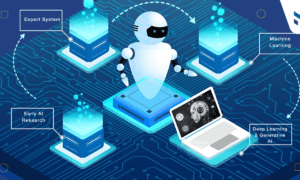Infrastructure as Code (IaC) is a modern IT practice that involves provisioning, configuring, and managing computing infrastructure such as servers, storage systems, networks, and other resources using machine-readable definition files instead of relying on manual hardware configuration or interactive configuration tools. By expressing infrastructure requirements through code, IaC enables organizations to automate deployments, enforce consistency across development, testing, and production environments, and minimize human error.
This approach leverages version-controlled code repositories and integrates seamlessly with CI/CD pipelines, allowing infrastructure to be deployed, modified, and scaled in a predictable and repeatable manner. As a result, IaC enhances agility, promotes collaboration between development and operations teams, and supports the principles of DevOps and cloud-native architecture
Rahul Amte: The Pioneering Senior Cloud Engineer of AI-Driven IaC
Rahul Amte is an experienced and highly skilled senior cloud operations engineer, DevOps engineer, system engineer, and infrastructure engineer. He has specialized in scaling and automating cloud workloads for over a decade. For the past few years, Amte has become proficient in developing AI-driven IaC methodologies for more secure and scalable cloud solutions across multiple cloud platforms, including Google Cloud, AWS, and Azure.
Amte received the 2025 Global Leader in Cloud AI and Machine Learning Operations Award by G L Award International for his accomplishments in producing outstanding results and innovations in cloud AI infrastructure engineering. His exceptional contributions to cloud computing and AI infrastructure have significantly impacted several industries, including finance, insurance, technology, and healthcare.
Amte is a true leader in modernizing and automating cloud systems to keep up with the growing demands on organizational infrastructure today. He knows firsthand how to utilize the true power of cloud technology by using his knowledge of platform engineering, IoT AI integration, machine learning operations, and DevSecOps (Development Security and Operations).
Amte discusses how integrating AI into IaC automates cloud deployments and configuration management, optimizing efficiency, reducing human error, and enabling predictive maintenance. Amte highlights tools like Terraform and Ansible, and the benefits of AI in managing multi-cloud environments, reducing costs, and accelerating DevOps workflows. With his expertise, Amte is shaping the future of cloud infrastructure by advancing AI-powered automation across global industries.
The Rise of AI-Driven Infrastructure as Code
IaC software tools let users change, build, and configure their infrastructure in a cloud-based system with code. You no longer need to be in one location to manage the digital infrastructure since it is stored on cloud-based servers, where authorized users can manage it from any location with a laptop and internet connection.
Some of the most popular IaC software tools include AWS CloudFormation, Ansible, and Terraform. They enable teams to modify coding in configuration files to make changes to the infrastructure. It certainly was an improvement over the classic way of managing computing infrastructure because it reduced the number of manual errors and helped make infrastructure provisioning more efficient and scalable.
However, the increased demands placed on existing infrastructure are no longer sustainable if it relies on people to manually manage the configuration files. Automating cloud deployments and configuration management using artificial intelligence (AI) is the only solution to sustain the increased demand.
AI-driven IaC can optimize infrastructure management and configuration by automatically analyzing data patterns, flagging security flaws, offering recommendations, and applying remedies to system failures and problems. Rather than defining infrastructure components in coding, the AI-driven IaC can actively adjust infrastructure resources as real-time events and actions occur.
Autonomous Infrastructure Management
AI-driven cloud-based IaC is giving rise to the phenomenon of autonomous infrastructure management. This transformative trend will eliminate the need to depend on predefined rules to manage infrastructure automatically.
The newest AI systems can continuously monitor the health and stability of existing infrastructure to immediately detect inefficiencies, such as misconfigurations, network saturation, and memory leaks. All corrective actions are taken without needing any human input. AI-driven IaC creates a self-healing infrastructure by activating automated scripts to address these problems before they cause any real harm.
One real-world trending example of the transition from manual intervention to AI autonomous system is the Google Kubernetes Engine (GKE) autopilot mode. It eliminates much of the time and energy spent managing Kubernetes clusters by allowing AI to oversee node and infrastructure security, monitoring, scaling, updating, and provisioning.
Predictive Maintenance and Preventing Downtime
The only thing better than catching problems in real time is to prevent problems and downtime. AI-driven IaC can offer predictive maintenance to cloud-based infrastructure automation practices. In addition to being reactive to problems, AI’s machine learning algorithms can continuously analyze data to make forecasts and predictions of potential infrastructure issues that are likely to occur before they do. That way, it can take automated proactive measures to remedy these risks to prevent failures and downtime while ensuring more resilience and better performance.
Cost Optimization to Reduce Operational Expenses
AI-driven IaC solutions can help reduce the cost and expenses of operating digital infrastructure. For instance, AI can help scale your infrastructure and prevent overprovisioning by tracking usage trends, identifying unused “zombie” resources, and predicting future costs. Based on this information, the AI can make more cost-efficient configuration changes to reduce your overhead expenses for infrastructure management.
Multi-Cloud Deployments
Many companies now rely on multi-cloud deployment to manage their digital infrastructure across several cloud providers because each offers unique benefits and capabilities for handling workloads and services. This type of flexibility is a great way to improve performance because only the best cloud service is used to execute a particular task.
AI-driven IaC eliminates the complexity of multi-cloud deployment and configuration by automating the entire process. For instance, the AI will automatically make cloud recommendations for workloads based on their specific characteristics. Then, it will adjust the configurations to accommodate each cloud-based environment’s particular policies, price, and performance, whether Google Cloud or AWS.
Faster Continuous Deployment of DevOps Workflows
DevOps integrates and automates information technology and software development operations to produce better quality and more reliable software faster. This process requires constant collaboration and feedback between IT operations teams and software development teams to ensure that new software is deployed quickly and efficiently.
AI-driven IaC can speed up the continuous deployment of DevOps workflows by automatically collaborating with DevOps teams to review code, enforce compliance, and suggest remedies to common misconfigurations and discrepancies. The accelerated feedback and predictive insights will help teams work faster and avoid potential problems with new deployments, such as increased CPU usage exceeding current thresholds.
Conclusion
AI-driven IaC is the future of modern infrastructure and cloud deployments. Companies and organizations will rely on AI-driven IaC to optimize performance, reduce operational expenses, improve security, and avoid misconfigurations and other efficiencies whenever possible.
Amte will pave the way for other cloud operations engineers to follow in his footsteps and expand AI-driven IaC to organizational infrastructure across all countries and regions worldwide.































